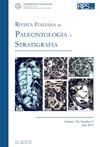来自意大利博尔卡始新世的一种新的摩尔神像(teleostei, zanclidae)
IF 1.6
3区 地球科学
Q2 GEOLOGY
引用次数: 0
摘要
刺尾鱼科 Zanclidae 的成员通常被称为摩尔神像,到目前为止,该科只有两个物种,即现存的 Zanclus cornutus 和始新世的 Eozanclus brevirostris。在此,我们根据三件来自新石器时代的标本,描述了一种新的摩尔神像--Angiolinia mirabilis n. gen. et sp、从形态上看,Angiolinia mirabilis n. gen. et sp. 似乎介于 Eozanclus brevirostris 和 Zanclus cornutus 之间,与它们的区别在于:体深 85-87% SL;头长 38.3-39.2% SL;第三背鳍棘约达 50%SL;胸盘宽 23.比较骨学分析表明,瓒鳞科有两个形态特征,即有一个宽大的、前腹部外凸的裂片,与冠状体一起形成所谓的胸鳍盘,并有大量的背鳍和臀鳍鳍条。产于博尔卡的始新世棘皮动物 Massalongius gazolai 是瓒科的姊妹群。在瓒科中,Eozanclus brevirostris 与 Angiolinia mirabilis n. gen. et sp.该支系的共同特征是:第一背鳍翼足上有一个编外棘突,尾部骨骼中有一个尿囊,除前两个背鳍棘突外,其他棘突上部均为丝状。本文章由计算机程序翻译,如有差异,请以英文原文为准。
A NEW MOORISH IDOL (TELEOSTEI, ZANCLIDAE) FROM THE EOCENE OF BOLCA, ITALY
The acanthuriform family Zanclidae, whose members are commonly known as moorish idols, has until now been comprised of two species, the extant Zanclus cornutus and the Eocene Eozanclus brevirostris. Herein, a new moorish idol, Angiolinia mirabilis n. gen. et sp., is described based on three specimens from the Eocene Pesciara site of the Bolca locality, northern Italy.
Morphologically, Angiolinia mirabilis n. gen. et sp. appears to be intermediate between Eozanclus brevirostris and Zanclus cornutus and differs from them by having the following features: body depth 85–87% SL; head length 38.3–39.2% SL; third dorsal-fin spine reaching about 50% SL; pectoral disc width 23.2% SL; dorsal fin containing 31 or 32 rays; anal fin containing 26 or 27 rays; pectoral fin with 11 or 12 moderately elongate rays and caudal fin truncate.
A comparative osteological analysis suggests that the family Zanclidae is defined by two morphological features, namely the presence of a broadly expanded and anteroventrally convex cleithrum forming the so-called pectoral disc together with the coracoid and having a large number of dorsal- and anal-fin rays. The Eocene acanthuriform Massalongius gazolai from Bolca represents the sister group to the Zanclidae. Within the zanclids, Eozanclus brevirostris represents the sister group to the pair formed by Angiolinia mirabilis n. gen. et sp. and Zanclus cornutus. This clade is supported by the shared possession of a single supernumerary spine on the first dorsal-fin pterygiophore, a single uroneural in the caudal skeleton, and all but the first two dorsal-fin spines distally filamentous.
求助全文
通过发布文献求助,成功后即可免费获取论文全文。
去求助
来源期刊
CiteScore
3.60
自引率
4.30%
发文量
28
审稿时长
>12 weeks
期刊介绍:
The Rivista Italiana di Paleontologia e Stratigrafia was founded in 1895. It publishes original papers dealing with all fields of paleontology and of stratigraphy, from Italy and the Mediterranean to the Tethys, as well across the globe from China to North America.

 求助内容:
求助内容: 应助结果提醒方式:
应助结果提醒方式:


